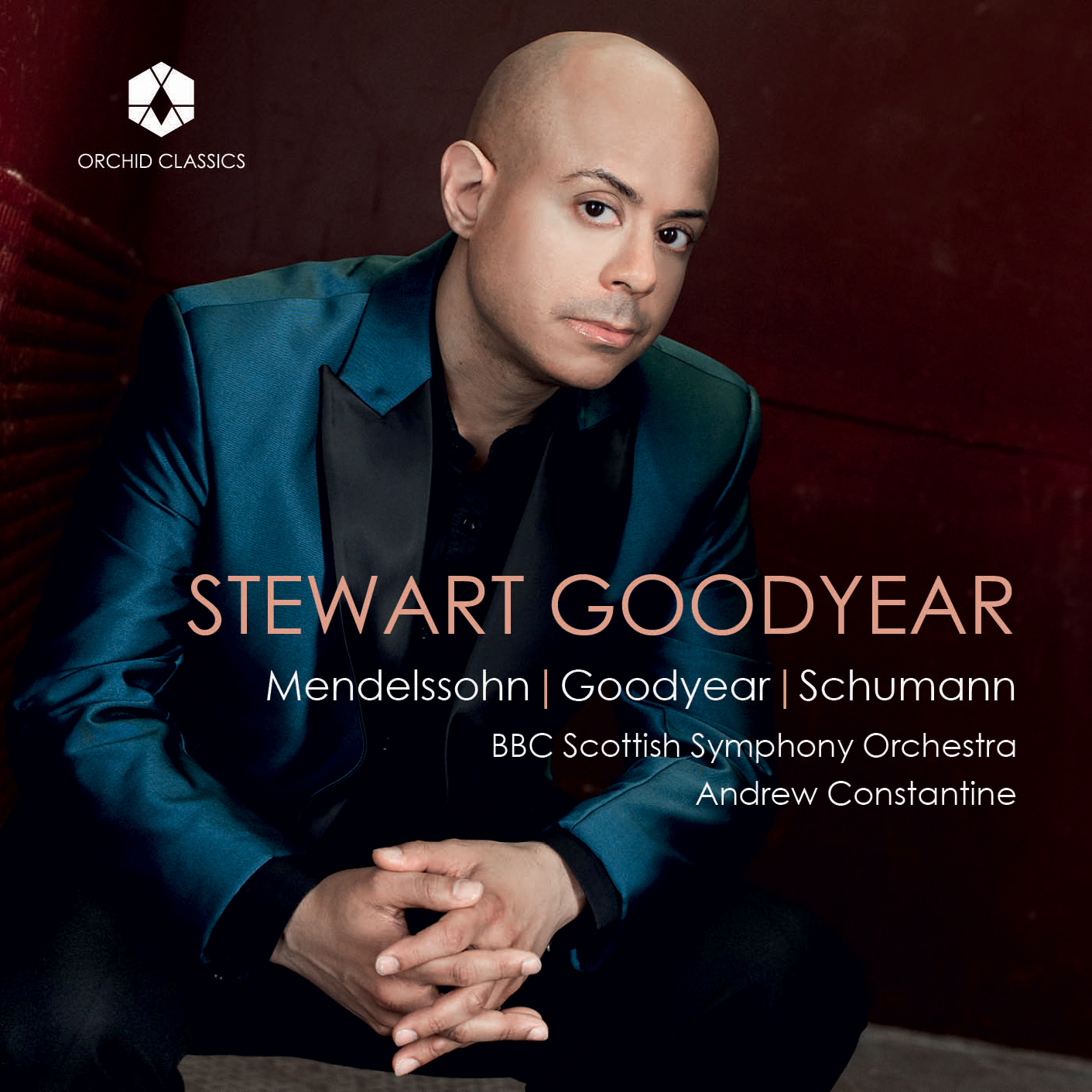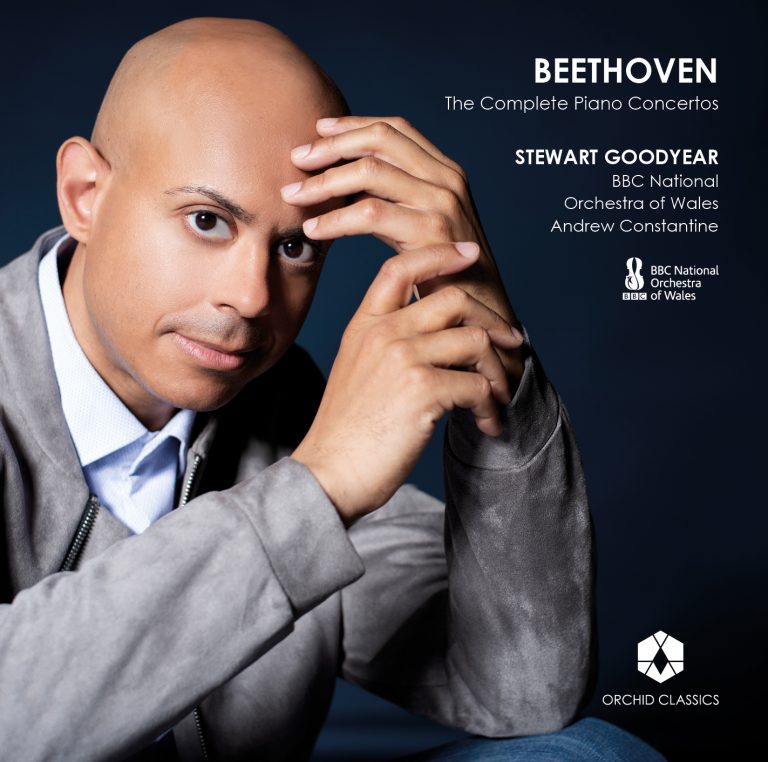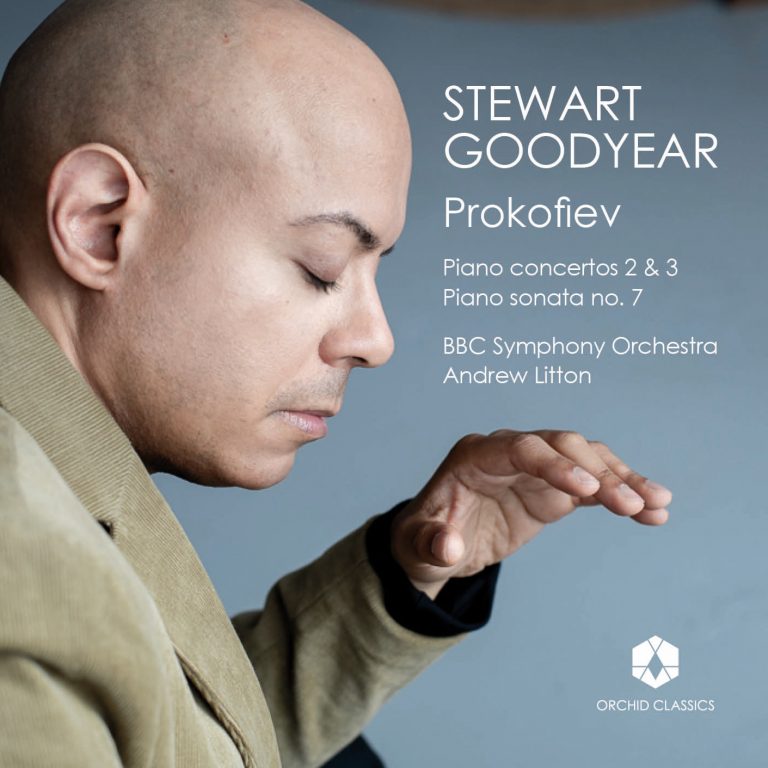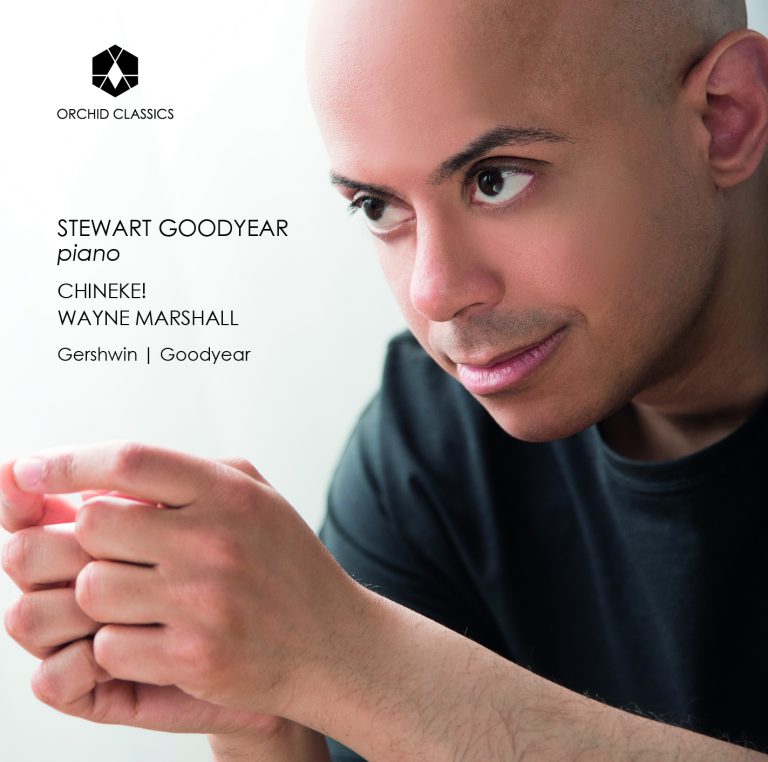Artist Led, Creatively Driven

STEWART GOODYEAR
Mendelssohn | Goodyear | Schumann
Stewart Goodyear, piano
BBC Scottish Symphony Orchestra
Andrew Constantine, conductor
Release Date: Feb 14th 2025
ORC100365
Robert Schumann (1810-1856)
Piano Concerto in A minor, Op.54
1. I Allegro affettuoso
2. II Intermezzo: Andantino grazioso –
3. III Allegro vivace
Stewart Goodyear (b.1978)
4. Rhapsody (2021)*
Felix Mendelssohn (1809-1847)
Piano Concerto No.1 in G minor, Op.25
5. I Molto allegro con fuoco –
6. II Andante –
7. III Presto – Molto allegro e vivace
Stewart Goodyear
8. Introduction and Rondo Capriccioso (2022)*
Stewart Goodyear, piano
BBC Scottish Symphony Orchestra
Andrew Constantine, conductor
*World Premiere Recording
From time immemorial, it is no secret that some of the most famous and timeless music ever written has been inspired by love. Composers have been compelled to create works based on their love for someone, either secretly or publicly. The Adagietto from Mahler’s 5th Symphony, for example, is the perfect depiction of his feelings for his wife, Alma. Berlioz’s infatuation with actress Harriet Smithson was the basis of his Symphonie Fantastique, and Brahms’ love for both Clara and Robert Schumann, platonic or not, permeates most of his work. The story of Romeo and Juliet has inspired Berlioz, Tchaikovsky, Prokofiev and Bernstein to write music that have moved and enchanted listeners ever since.
The Romantic movement of music, beginning in the early 19th century, enabled composers to write works with more emotional and dramatic abandon, broadening themes, and expanding dynamics. Program music, later in this movement, became very common, as well as song cycles and rhapsodies. Each work from that period was challenging the previous classical conventions and moderations that have been a rule of composition. Before the Romantic period, the Classical aesthetic was the “head and the heart” in equal measure, restraint being the norm. Beethoven challenged the norm by incorporating daring harmonies, virtuosity, trancelike repetitions, and expansion of suspense to his symphonies and sonatas, and created a bridge between the Classical and Romantic periods. Wagner’s Tristan and Isolde completely turned music on its head by breaking every operatic and harmonic tradition and created a bridge between the Romantic and modern music of the 20th century. The inspiration: you guessed it…Love.
Mendelssohn and Schumann
Felix Mendelssohn is a composer famous for writing works that balanced Romantic abandon with Classical restraint. There is a feeling of control, balance, and measurement to his melodies, orchestration and harmonies. These qualities, however, cover a rebellious, whimsical character that define a lot of Mendelssohn’s music. His first concerto in G minor, a connected three-movement work composed in 1831, broke away from the traditional Mozartian concerto by having the solo piano furiously plunge into the fire after a few seconds of orchestral introduction, and combining the three movements rhapsodically and operatically. It is also a thrilling showpiece filled with dizzying virtuosity, poised lyricism, and colour. The soloist is front and center, and when the orchestra shares in the lyric duties in the first and second movements, the soloist accompanies with non-stop flying fingers. Mendelssohn dedicated his concerto to pianist Delphine von Schauroth when he met her in Munich at the age of 21. According to some reports, young Felix was smitten by young Delphine and was thinking of proposing to her. Young Victorian courtship, as well as young fire, is in this concerto. The second movement is a poem that combines poetry and fancy, and the third movement a dopamine release after love’s first kiss.
If Mendelssohn’s concerto is a testament to attraction, Schumann’s is full-blown deep attachment. This concerto was written for, and premiered by, Clara in 1845. Their love for each other was being put to the test by Clara’s father who bitterly opposed their union. Letters to each other were filled with ache and longing. When they finally married, Robert wrote his 26 songs, Op.25, to Clara as a wedding present. This longing and art of song is everywhere in Robert’s Concerto to Clara. One can hear the feelings expressed in their letters, and there is also a sense of resolve that love will conquer all obstacles if they hold tight. The first movement opening, similar to Mendelssohn, leaves no room for convention. The orchestra does not even give the soloist an introduction, but a sharp strike. (I always hear Clara’s father shouting “No!” in that first note.)
The pianist responds with a fierce counterattack, using wild harmonies that have almost nothing to do with A-minor until the soloist and orchestra come together for two more strikes. This arresting opening sets up the Florestan and Eusebius element of the first movement that was not only Robert’s personality, but also reflected what the young Clara and Robert were going through. The second movement Intermezzo feels like one is eavesdropping on a very personal phone call between two lovers, and the ingenious call back to the first movement before the exuberant finale is storytelling at its best. Fighting for love and ultimately succeeding is what makes the third movement such a joyful and triumphant ending. The intimacy of Schumann’s concerto is the other clue to why this work has endured. The soloist and orchestra are equal protagonists. The pianism in the solo part is not about chest-beating bravura, but about communication, giving and taking, listening and bonding, and collaboration. In short, Robert’s concerto is a love letter to his beloved and their relationship, and the work’s intimacy and vulnerability always bring the listener in.
Personal notes about my two works on this album
When I met Steven Law in summer 2022 in Rockport, he spoke with me about memories of his late husband, Dr. William D. “Donald” Stroud. I was deeply moved by their relationship, what they shared, and the way Steven spoke with love as well as the deep loss. I told him how moved I was and how inspired, and he asked me to write a work that paid homage to their relationship. This work is perhaps the most intimate I have ever written. Saying more about this work will not do justice, and I very much hope that the listener feels the love expressed in this music. I was commissioned to write a piano work for the Honens International Piano Competition in 2021, and “Introduction and Rondo Capriccioso” was the result – a virtuosic piano composition written in the spirit of Mendelssohn but inspired by music of Sub-Saharan Africa. The piece opens with a 46-bar serenade of harmony and colour, creating an atmosphere improvisatory and mysterious until it stops on an A-flat chord. The A-flat then repeats and takes on a drumming effect before the Rondo takes off, the rhythm of 3/8 and 6/16 dominating the dance. The middle theme, established in bold octaves in the right hand, and which repeats near the end of the work, takes the spirit of a chant.
Working on the album was an immense joy, and it was a pleasure to work again with the musical family who made my dream of recording Beethoven’s Complete Concertos a beautiful reality: conductor Andrew Constantine, producer Andrew Keener, engineer and mastering Dave Rowell, editor Matthew Swan, and Matthew Trusler of Orchid Classics. I also deeply thank the wonderful members and staff of the BBC Scottish Symphony Orchestra.
Stewart Goodyear
Piano
Proclaimed “a phenomenon” by the Los Angeles Times and “one of the best pianists of his generation” by the Philadelphia Inquirer, Stewart Goodyear is an accomplished concert pianist, improviser and composer. Mr. Goodyear has performed with, and has been commissioned by, many of the major orchestras and chamber music organizations around the world.
Orchid Classics released Mr. Goodyear’s recording of his suite for piano and orchestra, “Callaloo” and his piano sonata. His recent commissions include a Piano Quintet for the Penderecki String Quartet, a piano work for the Honens Piano Competition, and a piano trio for the Horszowski Trio. His composition for solo cello and piano, “The Kapok” was recorded by Inbal Negev and Mr. Goodyear, and his suite for solo violin, “Solo”, was commissioned and recorded by Miranda Cuckson. Mr. Goodyear’s new work, “Life, Life, Life”, commissioned by the Chineke! Orchestra was performed by the same forces at the Southbank Centre May 2024.
Mr. Goodyear’s discography includes the complete sonatas and piano concertos of Beethoven, as well as concertos by Tchaikovsky, Grieg and Rachmaninov, an album of Ravel piano works, and an album, entitled “For Glenn Gould”, which combines repertoire from Mr. Gould’s US and Montreal debuts. His Rachmaninov recording received a Juno nomination for Best Classical Album for Soloist and Large Ensemble Accompaniment. Mr. Goodyear’s recording of his own transcription of Tchaikovsky’s “The Nutcracker (Complete Ballet)”, was chosen by the New York Times as one of the best classical music recordings of 2015.
Recent appearances have included his Carnegie Hall debut with the Royal Conservatory Orchestra of Toronto May 2024, his performance of his “Callaloo” Suite with the Chineke! Orchestra under conductor Andrew Grams at the Schleswig-Holstein Music Festival, his return to the Ladies Morning Musical Club in Montreal, Canada, and performances with the Milwaukee and Nashville Symphony orchestras, the Buffalo Philharmonic, and his debut with the City of Birmingham Symphony Orchestra and the Korean National Symphony Orchestra. Highlights for the 2024-25 season are his performances at the BBC Proms with the Chineke! Orchestra, performances at the Rheingau Musik Festival, and performances with the Indianapolis, Vancouver and Toronto Symphonies, the Rochester Philharmonic, Frankfurt Museumorchester, and A Far Cry in Boston.
Andrew Constantine
Conductor
Andrew Constantine serves as Music Director of both the Fort Wayne Philharmonic and the Reading Symphony Orchestra. Having gained a reputation in Europe and the UK as a conductor of great skill, charisma, energy and versatility, Andrew Constantine moved to the US in 2004 to become Assistant Conductor of the Baltimore Symphony Orchestra. Within his first season there he was promoted to Associate Conductor.
In the US he has won great praise for his ability to communicate with audiences and his energetic and compelling advocacy for classical music has gained him many admirers. After winning the first Donatella Flick/Accademia Italiana Conducting Competition, Andrew Constantine studied with the legendary Ilya Musin in Leningrad who described him as “a brilliant representative of the conducting art”. After his Royal Festival Hall debut with the London Philharmonic press reviews were unanimous in their praise: “Definiteness of intention is a great thing, and Constantine’s shaping of the music was never short of it” was the Financial Times’ view, whilst The Independent wrote, “Andrew Constantine showed a capacity RFH audience just what he is made of, ending his big demanding programme with an electrifying performance of Prokofiev’s Symphony No.5.”
Andrew Constantine has worked with the UK’s leading orchestras including The Philharmonia, Royal Philharmonic, London Symphony and Halle Orchestras, and many others throughout Europe, including the St. Petersburg Philharmonic, Trondheim Symphony and the NWD-Philharmonie. He holds an Honorary Degree of Doctor of Music from the University of Leicester for this “contribution to music”, and also a prestigious British NESTA Fellowship to further develop his international career. Recent recordings with the BBC National Orchestra of Wales and BBC Scottish Symphony Orchestra of music by Elgar, Beethoven, Chadwick and Patrick O’Malley have received wide praise.
BBC Scottish Symphony Orchestra
Formed in 1935, the BBC Scottish Symphony Orchestra has been based at Glasgow’s City Halls since 2006. It has a rich history of performing, broadcasting, and recording across Scotland and the rest of the UK, and of touring overseas, most recently to South America, China, India, and Japan.
Its huge range of repertoire has developed under its Chief Conductors, who include Osmo Vänskä, Ilan Volkov, Sir Donald Runnicles (now Conductor Emeritus), Thomas Dausgaard, and, since September 2022, Ryan Wigglesworth. It has long been a champion of new music, not least through Tectonics, its annual festival of the new and experimental, and it has established strong links with local communities through its learning and outreach programmes. It is a partner in Big Noise, Scotland’s project for social change through music, and it maintains a close association with the Royal Conservatoire of Scotland, in Glasgow, working across a variety of disciplines with conductors, composers, soloists, and orchestral players.
The BBC Scottish Symphony Orchestra maintains a busy schedule of broadcasts on BBC Radio 3, BBC iPlayer, BBC Radio Scotland, and BBC television. It appears regularly at the BBC Proms and Edinburgh International Festival and is a recipient of the Royal Philharmonic Society Award for Ensemble and of four Gramophone Awards.









